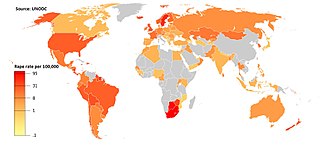
Hentai is a style of Japanese pornographic anime and manga. In addition to anime and manga, hentai works exist in a variety of media, including artwork and video games.

Sexual harassment is a type of harassment involving the use of explicit or implicit sexual overtones, including the unwelcome and inappropriate promises of rewards in exchange for sexual favors. Sexual harassment can be physical and/or a demand or request for sexual favors, making sexually colored remarks, showing pornography, and any other unwelcome physical, verbal, or non-verbal conduct of a sexual nature. Sexual harassment includes a range of actions from verbal transgressions to sexual abuse or assault. Harassment can occur in many different social settings such as the workplace, the home, school, or religious institutions. Harassers or victims can be of any gender.
Heterosexism is a system of attitudes, bias, and discrimination in favor of heterosexuality and heterosexual relationships. According to Elizabeth Cramer, it can include the belief that all people are or should be heterosexual and that heterosexual relationships are the only norm and therefore superior.
Victim blaming occurs when the victim of a crime or any wrongful act is held entirely or partially at fault for the harm that befell them. There is historical and current prejudice against the victims of domestic violence and sex crimes, such as the greater tendency to blame victims of rape than victims of robbery if victims and perpetrators knew each other prior to the commission of the crime. The Gay Panic Defense has also been used to justify violence against LGBTQ people.

Rape culture is a setting, as described by some sociological theories, in which rape is pervasive and normalized due to that setting's attitudes about gender and sexuality. Behaviors commonly associated with rape culture include victim blaming, slut-shaming, sexual objectification, trivializing rape, denial of widespread rape, refusing to acknowledge the harm caused by sexual violence, or some combination of these. It has been used to describe and explain behavior within social groups, including prison rape and in conflict areas where war rape is used as psychological warfare. Entire societies have been alleged to be rape cultures.
Date rape is a form of acquaintance rape and dating violence. The two phrases are often used interchangeably, but date rape specifically refers to a rape in which there has been some sort of romantic or potentially sexual relationship between the two parties. Acquaintance rape also includes rapes in which the victim and perpetrator have been in a non-romantic, non-sexual relationship, for example as co-workers or neighbors.
The men's liberation movement is a social movement critical of the restraints which society imposes on men. Men's liberation activists are generally sympathetic to feminist standpoints.
Hypermasculinity is a psychological and sociological term for the exaggeration of male stereotypical behavior, such as an emphasis on physical strength, aggression, and human male sexuality. In the field of clinical psychology, this term has been used ever since the publication of research by Donald L. Mosher and Mark Sirkin in 1984. Mosher and Sirkin operationally define hypermasculinity or the "macho personality" as consisting of three variables:
Rape is a traumatic experience that affects the victim (survivor) in a physical, psychological, and sociological way. Even though the effects and aftermath of rape differ among victims, individuals tend to suffer from similar issues found within these three categories. Long-term reactions may involve the development of coping mechanisms that will either benefit the victim, such as social support, or inhibit their recovery. Seeking support and professional resources may assist the victim in numerous ways.

Rape is a type of sexual assault involving sexual intercourse, or other forms of sexual penetration, carried out against a person without their consent. The act may be carried out by physical force, coercion, abuse of authority, or against a person who is incapable of giving valid consent, such as one who is unconscious, incapacitated, has an intellectual disability, or is below the legal age of consent. The term rape is sometimes casually inaccurately used interchangeably with the term sexual assault.
Intimate partner violence (IPV) is domestic violence by a current or former spouse or partner in an intimate relationship against the other spouse or partner. IPV can take a number of forms, including physical, verbal, emotional, economic and sexual abuse. The World Health Organization (WHO) defines IPV as "any behavior within an intimate relationship that causes physical, psychological or sexual harm to those in the relationship, including acts of physical aggression, sexual coercion, psychological abuse and controlling behaviors." IPV is sometimes referred to simply as battery, or as spouse or partner abuse.

Pornography has been defined as any material in varying forms, including texts, video, photos or audio that is consumed for sexual satisfaction and arousal of an individual or partnership. The effects of pornography on individuals or their intimate relationships have been a subject of research.
Sexual violence refers to a range of completed or attempted sexual acts in which the affected party does not or is unable to consent. Theories on the causes of sexual violence are numerous and have come out of many different disciplines, such as women's studies, public health, and criminal justice. Proposed causes include military conquest, socioeconomics, anger, power, sadism, traits, ethical standards, laws, and evolutionary pressures. Most of the research on the causes of sexual violence has focused on male offenders.

As sexual violence affects all parts of society, the responses that arise to combat it are comprehensive, taking place on the individual, administrative, legal, and social levels.
Ambivalent sexism is a theoretical framework which posits that sexism has two sub-components: hostile sexism (HS) and benevolent sexism (BS). Hostile sexism reflects overtly negative evaluations and stereotypes about a gender. Benevolent sexism represents evaluations of gender that may appear subjectively positive, but are actually damaging to people and gender equality more broadly. For the most part, psychologists have studied hostile forms of sexism. However, theorists using the theoretical framework of ambivalent sexism have found extensive empirical evidence for both varieties. The theory has largely been developed by social psychologists Peter Glick and Susan Fiske.
Campus sexual assault is the sexual assault, including rape, of a student while attending an institution of higher learning, such as a college or university. The victims of such assaults are more likely to be female, but any gender can be victimized. Estimates of sexual assault, which vary based on definitions and methodology, generally find that somewhere between 19 and 27% of college women and 6–8% of college men are sexually assaulted during their time in college.
Examples of misogyny exist in many published forms, within multiple cultures and well-observed works. Technological advances in the modern era have contributed proficient means to media and marketing to the resultant mass media in the 21st century. The merging of misogyny and mass media has made numerous examples where studies have concluded correlations between misogynous messages, both obvious and subliminal. Corresponding physical appearance of violence and hateful conduct may be seen relative to exposure.
The exploitation of women in mass media is the use or portrayal of women in mass media such as television, film, music, and advertising as objects or sexual beings, in order to increase the appeal of media or a product to the detriment of the women being portrayed, and women in society. This process includes the presentation of women as sexual objects and the setting of feminine beauty ideals that women are expected to reflect. Sexual exploitation of women in the media dates back to 19th century Paris, in which ballerinas were exposed to harassment and objectification. The most often criticized aspect of the use of women in mass media is sexual objectification, but dismemberment can be a part of the objectification as well. The exploitation of women in mass media has been criticized by feminists and other advocates of women's rights, and is a topic of discussion in feminist studies and other fields of scholarship.
Rape myths are prejudicial, stereotyped, and false beliefs about sexual assaults, rapists, and rape victims. They often serve to excuse sexual aggression, create hostility toward victims, and bias criminal prosecution.
The culture of violence theory addresses the pervasiveness of specific violent patterns within a societal dimension. The concept of violence being ingrained in Western society and culture has been around for at least the 20th century. Developed from structural violence, as research progressed the notion that a culture can sanction violent acts developed into what we know as culture of violence theory today. Two prominent examples of culture legitimizing violence can be seen in rape myths and victim blaming. Rape myths lead to misconstrued notions of blame; it is common for the responsibility associated with the rape to be placed on the victim rather than the offender.





